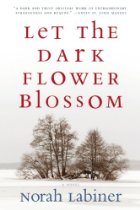What We’re Reading: Let the Dark Flower Blossom

 Let the Dark Flower Blossom by Norah Labiner (Coffee House Press, 2013)
Let the Dark Flower Blossom by Norah Labiner (Coffee House Press, 2013)
A murder. Twins. A desolate island. Lies. These were all of the things that intrigued me about Let the Dark Flower Blossom by Norah Labiner. And it delivered. Murder? Possibly several. Twins? Yep. A desolate island? Check. Lies? Too many to count.
It may sound unprofessional, but Let the Dark Flower Blossom is perhaps the postmodern-est, metafiction-iest book I’ve read. But that’s all my brain has left after finishing the book. This is both a good thing and a bad thing. I’m glad I experienced it. But it also brought back every insecurity I had in my college contemporary literature class. A book like Let the Dark Flower Blossom, with all of its twists, turns, lies, half-truths, and perhaps truths, leaves me utterly unsure of my abilities as a reader. What am I missing that all the intelligent readers are “getting”? For all of my marginalia crowding the book, I’m still not sure I fully understand what I just experienced. Let me try to work through it for you.
Twins Sheldon and Eloise Schell meet Roman Stone in college. Sheldon and Roman are roommates and writers, and Roman falls for Eloise. Roman becomes a successful writer, while Sheldon becomes just a writer. Eloise marries a lawyer who specializes in getting victims of crimes to question their memories of events. Roman is murdered, and no one knows who did it. Eloise and Sheldon must dredge up a past they’d rather forget in order to get the answers they need now.
Sheldon claims he only shares his true story with his neighbor, whose memory is failing.
Each night the doctor forgot the story that I had told him the night before. He forgot that I told him about Father and Mother. He forgot what I told him about Eloise. He forgot that I told him about Pru. He forgot that I told him about the woods.
This was the nature of Dr. Lemon’s disease.
He forgot.
And I confessed again.
I remembered.
This was the nature of my punishment.
I could not forget.
Labiner has many beautiful passages in the book, but she also makes sure the reader doesn’t forget. Taking into account the number of characters recalling the past and the number of times and various ways they do it, bits of stories and phrases are excessively repeated, and the reader almost wishes they were allowed the luxury of forgetting.
I love books that twist and turn and have big blindsiding reveals in the end, but Let the Dark Flower Blossom gives the reader very little, if anything, to hold on to. As the past actions of Roman and Sheldon come to light, they are told and retold several times, in several variations, by several characters. Which version is the reader to trust? I’m not sure the reader can trust anyone. At least I didn’t. And that’s what makes the book so frustrating. The rug can be pulled out from under a reader only so many times before they decide they don’t want to get up again.
But Labiner’s command of language is impressive, and the reader continues on to witness her skillful manipulation of her craft.
Somewhere between ink and ether.
Between shoe and sock.
And tock and tick.
And scissors and rock.
Between either and or—
The coffee drip by drop fell into the pot.
Lovely passages like this are the impetus for the reader to forge ahead with the decidedly murky story. Let the Dark Flower Blossom is not an easy book. I’m not even sure I can say it’s satisfying. But, it’s an experience. And Labiner’s writing can be exquisite, painful, and enlightening, sometimes all at once. That’s why I’ll gladly seek out her other books. After an appropriate rest period, of course.
What types of books bring out your insecurities as a reader? Do you shy away from those books or try to face those insecurities down?






Comments are closed.